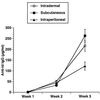Immunostimulatory oligodeoxynucleotides containing the CpG motif are effective as immune adjuvants in tumor antigen immunization
- PMID: 9380720
- PMCID: PMC23500
- DOI: 10.1073/pnas.94.20.10833
Immunostimulatory oligodeoxynucleotides containing the CpG motif are effective as immune adjuvants in tumor antigen immunization
Abstract
Recent advances in our understanding of the immune response are allowing for the logical design of new approaches to cancer immunization. One area of interest is the development of new immune adjuvants. Immunostimulatory oligodeoxynucleotides containing the CpG motif (CpG ODN) can induce production of a wide variety of cytokines and activate B cells, monocytes, dendritic cells, and NK cells. Using the 38C13 B cell lymphoma model, we assessed whether CpG ODN can function as immune adjuvants in tumor antigen immunization. The idiotype served as the tumor antigen. Select CpG ODN were as effective as complete Freund's adjuvant at inducing an antigen-specific antibody response but were associated with less toxicity. These CpG ODN induced a higher titer of antigen-specific IgG2a than did complete Freund's adjuvant, suggesting an enhanced TH1 response. Mice immunized with CpG ODN as an adjuvant were protected from tumor challenge to a degree similar to that seen in mice immunized with complete Freund's adjuvant. We conclude that CpG ODN are effective as immune adjuvants and are attractive as part of a tumor immunization strategy.
Figures






References
-
- Krieg A M, Yi A K, Matson S, Waldschmidt T J, Bishop G A, Teasdale R, Koretzky G A, Klinman D M. Nature (London) 1995;374:546–549. - PubMed
-
- Pisetsky D S, Reich C, Crowley S D, Halpern M D. Ann NY Acad Sci. 1995;772:152–163. - PubMed
-
- Stacey J J, Sweet M J, Hume D A. J Immunol. 1996;157:2116–2122. - PubMed
-
- Yamamoto S, Yamamoto T, Shimada T, Kuramoto E, Yano O, Kataoka T, Tokunaga T. Microbiol Immunol. 1992;36:983–997. - PubMed
-
- Messina J P, Gilkeson G S, Pisetsky D S. J Immunol. 1991;147:1759–1764. - PubMed
Publication types
MeSH terms
Substances
Grants and funding
LinkOut - more resources
Full Text Sources
Other Literature Sources

